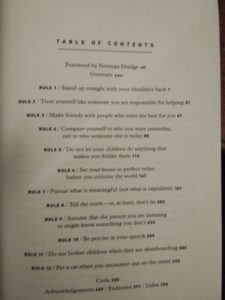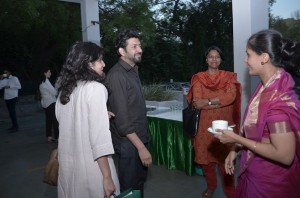[bwwpp_book sku=’97803458160230000000′]
Jordan Peterson’s 12 Rules for Life: An Antidote to Chaos lays down rules for a better living in a noisy modern  world. There is an authoritarian tone to the rules as listed in the table of contents. The arguments laid out in the book stem from his online discussions on the popular platform Quora.
world. There is an authoritarian tone to the rules as listed in the table of contents. The arguments laid out in the book stem from his online discussions on the popular platform Quora.
Every chapter is preceded by an alarmingly disturbing ink illustration involving children. “Alarming” because every single image rather than being hopeful and a cofidence building measure inevitably has a tone which hints that it is best where you are, do not try and have dreams. Take for instance Rule 3 which states “Make friends wtih people who want the best for you” is accompanied by an illustration of the statue of David by Michelangelo with a very tiny figure of a child looking up at this enormous statue. It looks positively monstrous in the illustration. It is a matter of perspective possibly but to have such distressing illustrations will serve the sole purpose of terrifying people, forcing them to remain where they are and to accept institutional systems and their social conditions as is, instead of questioning or being ambitious and hopeful. These forms of intellectual arguments are detrimental to the growth of an individual and for society at large but most people will know no better for undoubtedly Jordan Peterson is fairly persuasive in his arguments.
Pankaj Mishra in a justifiably scathing attack of Jordan Peterson’s book in the NYRB ( Jordan Peterson & Fascist Mysticism, 19 March 2018) has this to say:
In all respects, Peterson’s ancient wisdom is unmistakably modern. The “tradition” he promotes stretches no further back than the late nineteenth century, when there first emerged a sinister correlation between intellectual exhortations to toughen up and strongmen politics. This was a period during which intellectual quacks flourished by hawking creeds of redemption and purification while political and economic crises deepened and faith in democracy and capitalism faltered. Many artists and thinkers—ranging from the German philosopher Ludwig Klages, member of the hugely influential Munich Cosmic Circle, to the Russian painter Nicholas Roerich and Indian activist Aurobindo Ghosh—assembled Peterson-style collages of part-occultist, part-psychological, and part-biological notions. These neo-romantics were responding, in the same way as Peterson, to an urgent need, springing from a traumatic experience of social and economic modernity, to believe—in whatever reassures and comforts.
….
The “desperation of meaninglessness” widely felt in the late nineteenth century, seemed especially desperate in the years following two world wars and the Holocaust. Jung, Eliade, and Campbell, all credentialed by university education, met a general bewilderment by suggesting the existence of a secret, almost gnostic, knowledge of the world. Claiming to throw light into recessed places in the human unconscious, they acquired immense and fanatically loyal fan clubs. Campbell’s 1988 television interviews with Bill Moyers provoked a particularly extraordinary response. As with Peterson, this popularizer of archaic myths, who believed that “Marxist philosophy had overtaken the university in America,” was remarkably in tune with contemporary prejudices. “Follow your own bliss,” he urged an audience that, during an era of neoconservative upsurge, was ready to be reassured that some profound ancient wisdom lay behind Ayn Rand’s paeans to unfettered individualism.
Peterson, however, seems to have modelled his public persona on Jung rather than Campbell.
…
Peterson may seem the latest in a long line of eggheads pretentiously but harmlessly romancing the noble savage. But it is worth remembering that Jung recklessly generalized about the superior “Aryan soul” and the inferior “Jewish psyche” and was initially sympathetic to the Nazis. Mircea Eliade
was a devotee of Romania’s fascistic Iron Guard. Campbell’s loathing of “Marxist” academics at his college
concealed a virulent loathing of Jews and blacks. Solzhenitsyn, Peterson’s revered mentor, was a zealous Russian expansionist, who denounced Ukraine’s independence and
hailedVladimir Putin as the right man to lead Russia’s overdue regeneration.
Meanwhile the book continues to sell and has climbed the bestseller charts worldwide although it
never made it to the New York Times Bestseller list. So much so that Jordan Peterson was moved sufficiently to write a “Thank you note to booksellers” commending them for their good work. In the letter circulated he lists the 12 books which influenced his 12 rules. These are:
BEYOND GOOD AND EVIL by Friedrich Nietzsche
MAN’S SEARCH FOR MEANING by Viktor Frankl
MODERN MAN IN SEARCH OF A SOUL by Carl Jung
THE SACRED AND THE PROFANE by Mircea Eliade
THE ROAD TO WIGAN PIER by George Orwell
BRAVE NEW WORLD by Aldous Huxley
THE ELECTRIC KOOL-AID ACID TEST by Tom Wolfe
NOTES FROM UNDERGROUND by Fyodor Dostoevsky
CRIME AND PUNISHMENT by Fyodor Dostoevsky
ORDINARY MEN by Christopher Browning
THE GULAG ARCHIPELAGO by Alexander Solzhenitsyn
WUTHERING HEIGHTS by Emily Bronte
The fact is that Jordan Peterson like conservative intellectuals who through their tub thumping articles persuade individuals to focus on themselves increasingly and not necessarily look at the world in a broader context do far more damage to society. Writing such “self-help” books that explicitly encourage an individual to narrow their landscapes considerably to the microcosm create more havoc than be an “antidote to chaos”. An illustrative example is that he offers of a rape survivor to illustrate his Rule 9 “Assume that the person you are listening to might know something you don’t” is a a very messed up argument. There are pages and pages of his analysis and reporting his conversation with the victim but this particular passage stands out for its misogyny.
She talked a lot. When we were finished, she still didn’t know if she had been raped and neither did I. Life is very complicated.
Sometimes you have to change the way you understand everything to properly understand a single something. “Was I raped?” can be a very complicated question. The mere fact that the question would present itself in that form indicates the existence of infinite layers of complexity — to say nothing of “five times.” There are a myriad of questions hidden inside “Was I raped?: What is rape? What is consent? What constitutes appropriate sexual caution? How should a person defend herself? Where does the fault lie? “Was I raped?” is a hydra. If you cut off the head of a hydra, seven more grow. That’s life. Miss S would have had to talk for twenty years to figure out whether she had been raped.
As Pankaj Mishra points out:
Nowhere in his published writings does Peterson reckon with the moral fiascos of his gurus and their political ramifications; he seems unbothered by the fact that thinking of human relations in such terms as dominance and hierarchy connects too easily with such nascent viciousness such as misogyny, anti-Semitism and Islamophobia. He might argue that his maps of meaning aim at helping lost individuals rather than racists, ultra-nationalists, or imperialists. But he can’t plausibly claim, given his oft-expressed hostility to the “
murderous equity doctrine” of feminists, and other progressive ideas, that he is above the fray of our ideological and culture wars.
Writer Matt Haig in a different context had this to say on Twitter about feminism and patriarchal mindsets. It is applicable in the context of this book:
Jordan Peterson’s 12 Rules For Life is a book that will be discussed for years to come. Read it if you must while bearing in mind the larger picture of intellectual discourse.
Jordan Peterson 12 Rules For Life: An Antidote to Chaos Allen Lane, an imprint of Penguin Random House UK, London, 2018. Pb. pp.410 Rs 699
21 March 2018
 world. There is an authoritarian tone to the rules as listed in the table of contents. The arguments laid out in the book stem from his online discussions on the popular platform Quora.
world. There is an authoritarian tone to the rules as listed in the table of contents. The arguments laid out in the book stem from his online discussions on the popular platform Quora.
